Stepping into a new Doctor Who era can be daunting, especially when you’ve become deeply attached to the previous one. For me, after two immersive years with Tom Baker’s Fourth Doctor, complete with an ever-growing collection of iconic scarves, the prospect of Peter Davison’s Fifth Doctor felt both exciting and nerve-wracking. Tom Baker was the Doctor in my mind, a figure as definitive as Jodie Whittaker, my first Doctor. His presence echoed through the very concept of “Doctor.” So, what would this new incarnation bring? My anxiety was real, but so was my anticipation.
Peter Davison’s tenure as the 5th Doctor spanned Seasons 19-21, from January 4, 1982 (remarkably, the year of my birth!) to March 16, 1984. Continuing my journey through all 695 classic Doctor Who episodes, I’m here to share my initial feelings and evolving impressions of this fresh regeneration.
From Hesitation to Devotion: Embracing a New Doctor
Reflecting on my initial hesitation, I quickly transitioned to empathy for Peter Davison. If I felt a sense of change after two years with the Fourth Doctor, how immense must the pressure have been for Davison stepping into the TARDIS after Tom Baker’s incredible seven-year run? This realization sparked a surge of admiration. This was the actor brave enough to follow Tom Baker! Suddenly, my apprehension transformed into genuine excitement. “Bring it on!” became my new mantra.
My deep dive into the Fifth Doctor’s era began on Monday, June 17, 2024, and concluded on Thursday, June 24, 2024. Spoiler alert: I was far from disappointed.
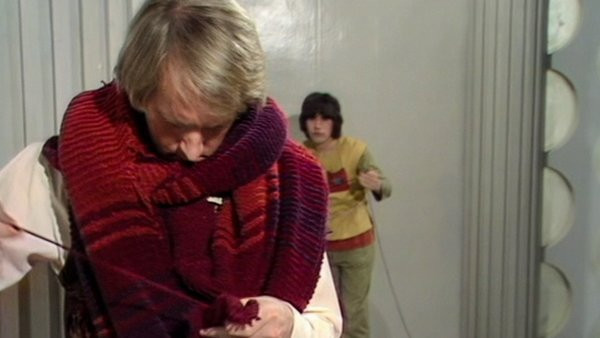 Freshly regenerated, the Doctor begins unraveling his old scarf while Adric follows him through the TARDIS to make sure he’s okay. / Photo Credit – BBC Studios’ Doctor Who
Freshly regenerated, the Doctor begins unraveling his old scarf while Adric follows him through the TARDIS to make sure he’s okay. / Photo Credit – BBC Studios’ Doctor Who
A Fresh Face, A New Era: The Fifth Doctor’s Transformation
Peter Davison’s debut episode, “Castrovalva: Part One,” immediately and BOLDLY declared the end of the Tom Baker era. This regeneration was turbulent, and as the 5th Doctor sought the Zero Room within the TARDIS for healing tranquility, he dramatically unraveled his iconic scarf to navigate back to the console room! For seven years, save for a single serial (“The Talons of Weng-Chiang”), the Doctor’s scarf had been an ever-present symbol. But now, it was gone. The visual cues didn’t stop there. Discarded shoes, a discarded coat, and a ripped vest further emphasized the message: a NEW Doctor, a new era had begun.
Shedding the Scarf: A Symbolic Change
The unravelling of the Fourth Doctor’s scarf was more than just a visual change; it was symbolic. It represented the shedding of the old and embracing the new. This deliberate act immediately signaled to viewers that this regeneration was not just a cosmetic alteration, but a fundamental shift in the Doctor’s persona and style. The scarf, a beloved and defining feature of the Fourth Doctor, was literally being unwound to pave the way for the Fifth Doctor’s distinct identity.
A Preppy Doctor with a Twist
Adjusting to the Fifth Doctor’s “preppy” aesthetic took a moment. After the Fourth Doctor, the quintessential bohemian vagabond with his wild curls, flowing scarf, and floppy hat, the 5th Doctor presented a stark contrast. Sneakers paired with slacks, a pullover sweater under his coat, and a button-down shirt – it was a departure. Of course, this was “preppy” with a Doctor-esque twist, complete with celery on his lapel, but the visual break from the previous era was undeniable and, in its own way, captivating. This new look was a deliberate choice to highlight the Fifth Doctor’s youthful energy and more grounded demeanor.
“The Doctor” Not “Doctor Who”: A Credit Distinction
Adding to the sense of novelty, the credits for Peter Davison’s first episode in season nineteen (and every subsequent episode) listed his character as “The Doctor,” not “Doctor Who”! This subtle yet significant change in the opening credits was a first in classic Doctor Who, further emphasizing the dawn of a new chapter and highlighting the character’s core identity.
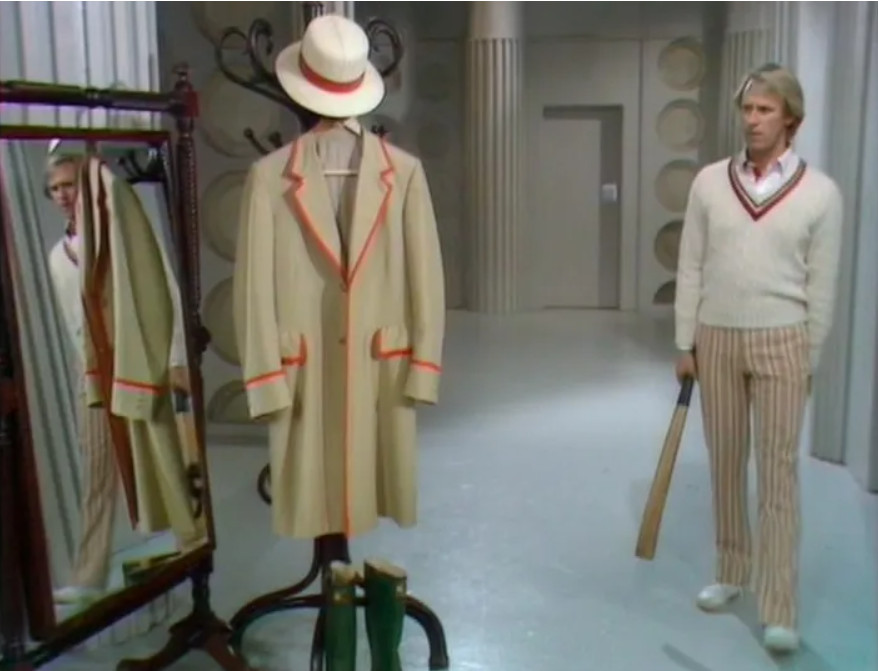 With cricket bat in hand, the Doctor wanders the TARDIS pulling together his new look. / Photo Credit – BBC Studios’ Doctor Who
With cricket bat in hand, the Doctor wanders the TARDIS pulling together his new look. / Photo Credit – BBC Studios’ Doctor Who
A TARDIS Family: The Dynamics of the Fifth Doctor’s Companions
The 5th Doctor continued his travels with Adric (Matthew Waterhouse), Nyssa (Sarah Sutton), and Tegan Jovanka (Janet Fielding), companions inherited from the Fourth Doctor’s era after Romana and K-9 remained in E-space. Their dynamic was instantly charming. The best analogy for the Fifth Doctor’s energy is a classic ’80s sitcom premise: he’s the young, hip, single dad navigating parenthood on his own. And I absolutely loved it. Even Nyssa and Tegan shared a room on the TARDIS, further solidifying the family atmosphere.
The ’80s Sitcom Vibe: Single Dad Doctor
The “single dad” sitcom analogy perfectly encapsulates the Fifth Doctor’s relationship with his companions. He is caring, often exasperated, and clearly trying his best to guide and protect his unconventional “family.” This dynamic brought a fresh and relatable element to Doctor Who, making the TARDIS feel less like just a spaceship and more like a home filled with quirky personalities and heartwarming interactions.
Tegan: The Sassy Eldest Daughter
Tegan embodied the sassy, sarcastic eldest daughter archetype. Self-described as “just a mouth on legs,” her sharp wit and outspoken nature provided constant comedic relief and a grounding presence amidst the fantastical adventures. Her sarcastic quips, like when searching for information in the Terileptil’s control room, highlight her no-nonsense attitude:
The Doctor – “Have a look around. See what papers you can find.”
Tegan – [sarcastically] “Oh, you think they’ll have left a forwarding address?”
The Doctor – “[yelling] WILL YOU…[deep breath, calmly] Just look around. There might be something.”
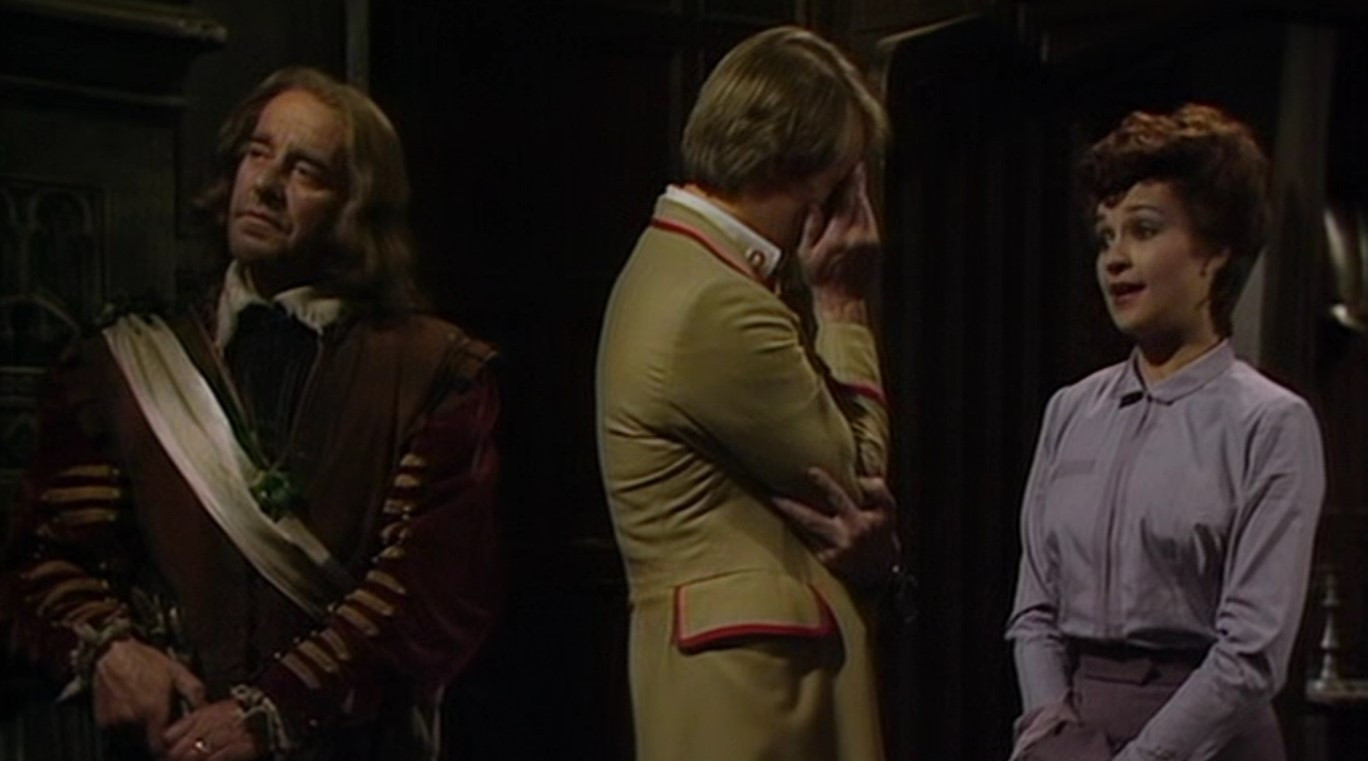 Tegan leaves the Doctor exasperated XD. / Photo Credit – BBC Studios’ Doctor Who
Tegan leaves the Doctor exasperated XD. / Photo Credit – BBC Studios’ Doctor Who
Nyssa: The Harmonious Middle Daughter
Nyssa, in contrast, was the “perfect” middle daughter, striving for harmony within their TARDIS family. Despite her youth, she often acted as a peacemaker, gently mediating between the Doctor and the more headstrong Tegan. Her desire for unity is evident in moments like when they encounter a distressed Tegan on Terminus:
The Doctor – “Tegan!”
Tegan – “Doctor…”
The Doctor – “What are you doing?”
Tegan – “I was trying to reach you. Turlough went back to the TARDIS on his own.”
The Doctor – “[sternly] I told you not to follow me.”
Nyssa – “Doctor, say you’re pleased to see her.”
The Doctor – “Yes, well I’m pleased to see her but she shouldn’t’ve followed us!”
Tegan – “[pleading] You don’t understand…”
The Doctor – “[dismissively] Yes, well we’ll talk about it later. [turning away] Valgard?”
Tegan – “[to Nyssa] Why does he never listen?”
Nyssa – “There’s a great deal to do.”
Tegan – “There always is.”
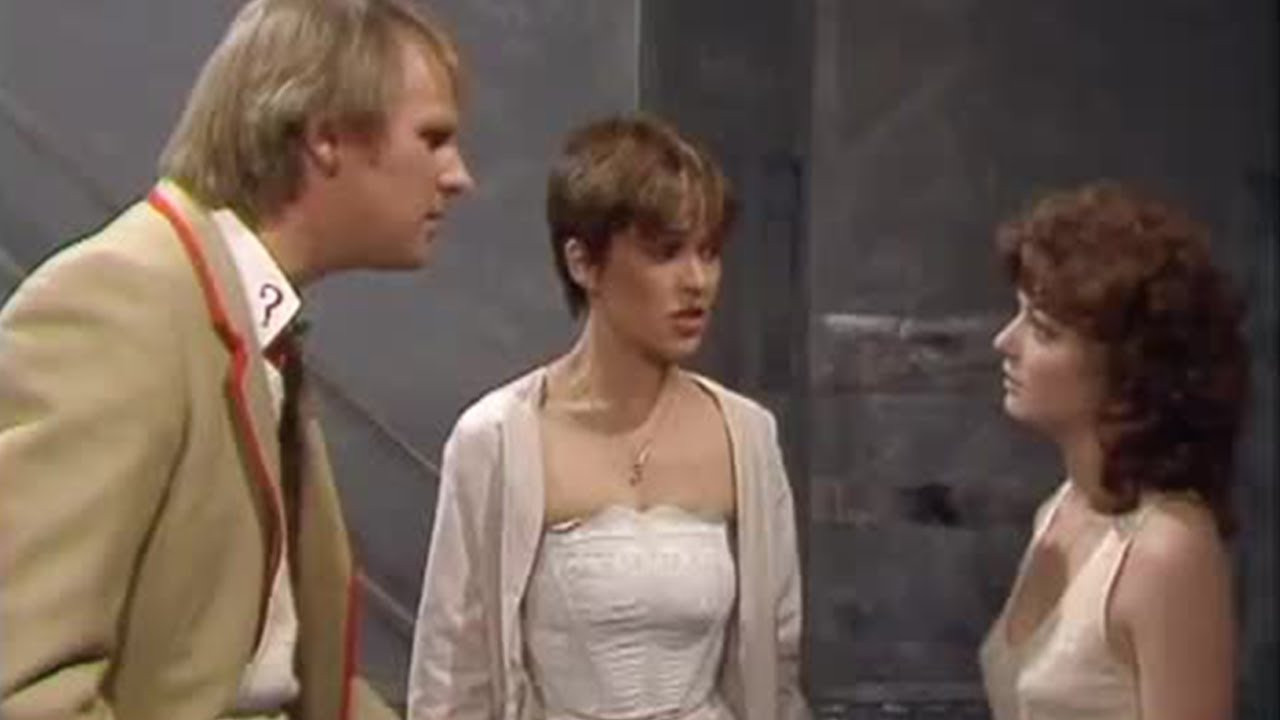 Nyssa does her best to create harmony between the Doctor and Tegan. / Photo Credit – BBC Studios’ Doctor Who
Nyssa does her best to create harmony between the Doctor and Tegan. / Photo Credit – BBC Studios’ Doctor Who
Adric: The Angsty Youngest Brother
Adric rounded out the family dynamic as the youngest brother, often doted upon by the Doctor, but also grappling with insecurity and a yearning to be seen as more mature. His teenage angst is palpable in his interactions with the Doctor, like this exchange in his TARDIS room:
The Doctor –“You must read this Adric, Black Orchid.”
Adric – “[monotone] Why?”
The Doctor – “It’s fascinating scholarship!”
Adric – “[opens the cover, closes it, puts it aside] Why should that interest me?”
The Doctor – “[gently] What’s the matter?”
Adric – “I’m fed up.”
The Doctor – “Why?”
Adric – “I’m tired of being considered a joke.”
 The Doctor tries to talk to Adric in his room and just gets alllllllll sorts of teenage angst. / Photo Credit – BBC Studios’ Doctor Who
The Doctor tries to talk to Adric in his room and just gets alllllllll sorts of teenage angst. / Photo Credit – BBC Studios’ Doctor Who
The Doctor – “Oh, no one thinks that!”
Adric – “Then why am I constantly teased?”
The Doctor – “Well, everyone’s teased from time to time.”
Adric – “Yeah, but not as often as me.”
The Doctor – “That’s not true.”
Adric – “No, and I suppose neither is the fact that whenever Nyssa or Tegan ask you a question you always find time to answer it, but hardly ever with me.”
[the Doctor fiddles with stuff on Adric’s desk.]
Adric – “[walking over to him’] “Look, how am I to learn if you never find time to explain?”
The Doctor – “Time? We have spent many hours discussing and debating endless topics!”
Adric – “I’m just fitted in when it’s convenient for you!”
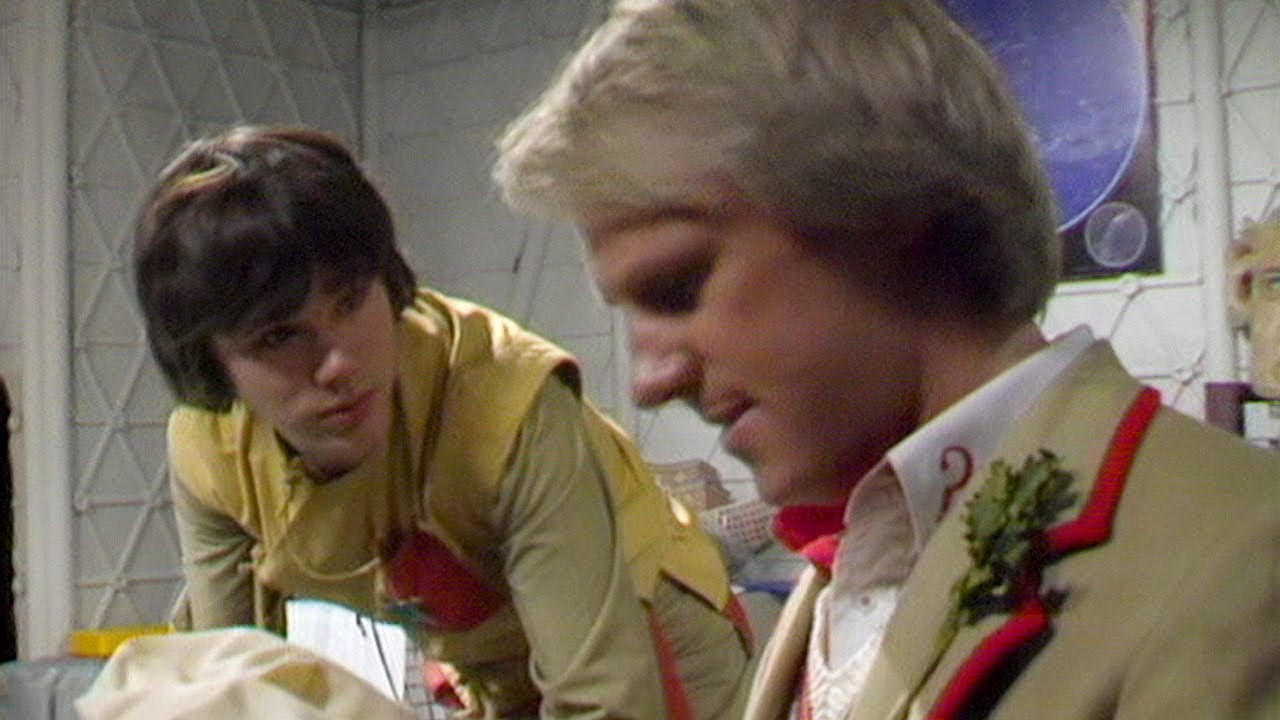 Ahh, kids, you know? / Photo Credit – BBC Studios’ Doctor Who
Ahh, kids, you know? / Photo Credit – BBC Studios’ Doctor Who
A Larger TARDIS Team: Family Dynamics
This family dynamic was truly endearing. A trip to 1925 revealed Tegan’s age allowed her to drink alcohol, while Nyssa and Adric, like the Doctor himself, opted for orange juice, highlighting their younger status. The Doctor traveling with a twenty-something and two teenagers was a refreshing change. It had been ages since the TARDIS wasn’t just occupied by the Doctor and a single female companion (K-9 notwithstanding). This larger team felt much more like a family unit, enriching the narrative.
The Fifth Doctor’s Personality: Empathy, Surprise, and Inspiration
The Doctor hadn’t exhibited such paternal energy since the First Doctor with Susan and Vicki, or the Second Doctor with Victoria. However, the Fifth Doctor’s paternal side felt different, more pronounced. We witnessed his genuine love and care for his companions, a blend of reprimands and praise, exasperation and pride, and an unwavering commitment to their protection as he unveiled the universe to them. This paternal aspect resonated deeply, adding a layer of emotional depth to his character.
A Warm and Empathetic Doctor
Beyond the paternal aspect, the 5th Doctor exuded warmth and empathy. He was deeply sensitive to the needs and feelings of his companions and those he encountered. This emotional intelligence made him incredibly relatable and further solidified the family dynamic within the TARDIS. His empathy wasn’t just a trait; it was a driving force in his actions and decisions.
The ‘Oh My Gosh’ Face: Sitcom Energy
Adding to his charm were the Fifth Doctor’s signature surprised, shocked, “oh-my-gosh-I’m-in-over-my-head-what-do-I-do” facial expressions. These moments further amplified the ’80s sitcom vibe and injected humor and relatability into even the most dramatic situations. These expressions were a visual shorthand for his often flustered but ultimately capable nature.
See what I mean?
 I love this so much. / Photo Credit – BBC Studios’ Doctor Who
I love this so much. / Photo Credit – BBC Studios’ Doctor Who
 He’s so cute! / Photo Credit – BBC Studios’ Doctor Who
He’s so cute! / Photo Credit – BBC Studios’ Doctor Who
Echoes in the Tenth Doctor: Davison’s Legacy
It’s evident that David Tennant drew significant inspiration from Peter Davison’s portrayal for his Tenth Doctor. The Fifth Doctor’s mannerisms – the way he carried himself, pushed back his coat to put hands in pockets, used glasses for reading or tech, and shifted from goofy to serious in danger – all resonate strongly with the Tenth Doctor. This lineage highlights the lasting impact of Davison’s performance on the modern era of Doctor Who.
Facing Familiar Foes and New Threats
Similar to Jodie Whittaker’s Thirteenth Doctor, the Fifth Doctor experienced a rough regeneration, leading to initial memory struggles. At the Castrovalva retreat center, when asked, “Who are you, stranger?” the Doctor replied, “That’s the strangest thing of all…I’m not entirely sure.” This parallel in regeneration difficulties connects the Fifth and Thirteenth Doctors, highlighting a recurring theme in the Doctor’s transformations.
The Terileptils: Visually Striking Villains
Among the aliens encountered by the Fifth Doctor, the Terileptils stood out as visually striking and memorable. In a series known for its imaginative creatures, the Terileptils were a fresh and compelling design. Their unique appearance reignited a sense of wonder and showcased the creativity of classic Doctor Who monster design. They were a welcome reminder that even in a long-running series, new and exciting alien designs could still captivate.
 The Terileptle and the Doctor / Photo Credit – BBC Studios’ Doctor Who
The Terileptle and the Doctor / Photo Credit – BBC Studios’ Doctor Who
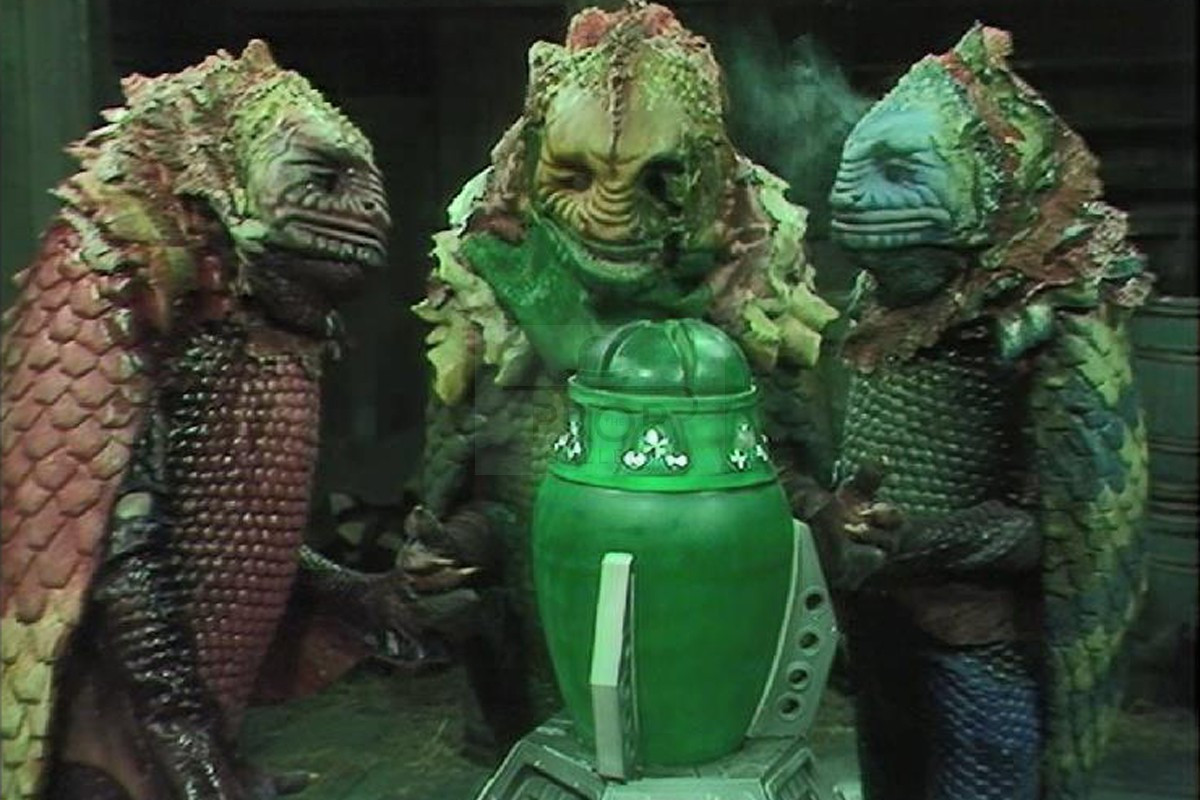 Ahhhh! See?!? They just look SO COOL. / Photo Credit – BBC Studios’ Doctor Who
Ahhhh! See?!? They just look SO COOL. / Photo Credit – BBC Studios’ Doctor Who
Colonization and Imperialism: Recurring Themes
The Terileptil storyline also introduced recurring themes of colonization and imperialism prevalent in the Fifth Doctor’s era. The Terileptils, escaping a life sentence, arrived on Earth with plans to wipe out the human population and claim the planet for themselves, justifying their actions by comparing it to humanity’s own history of displacing “primitive” species. These narratives provided social commentary and added depth to the sci-fi adventures. The ethical dilemmas of colonization and environmental stewardship became central to many Fifth Doctor stories, reflecting contemporary concerns.
The Sonic Screwdriver: A Less Frequent Tool
During this encounter, the Doctor’s sonic screwdriver was destroyed by the Terileptils. “I feel like I’ve lost an old friend,” he mourned to Nyssa. This moment highlighted a significant difference between classic and modern Doctor Who: the sonic screwdriver’s usage. In classic Doctor Who, the sonic screwdriver was a less ubiquitous tool, primarily used for simple tasks like unlocking doors. It wasn’t the ubiquitous, plot-solving device it became in modern iterations. This limitation emphasized the Doctor’s intellect and resourcefulness as his primary tools.
Nyssa’s Brilliance: A Capable Companion
In response to the crisis, the Doctor tasked Nyssa with building a device to stop the Terileptils. She succeeded brilliantly, showcasing her growing competence and intelligence. Throughout her time with the Doctor, Nyssa evolved into a highly capable companion, piloting the TARDIS, constructing necessary equipment, and solving mysteries with remarkable speed, often matching or even surpassing the Doctor’s own intellect. Her brilliance echoed companions like Zoe and Romana, reinforcing the appeal of having intellectually equal partners for the Doctor.
Classic Companions: Beyond Earth Humans
This era highlighted a contrast with modern Doctor Who’s companion choices. Classic Doctor Who frequently featured companions from diverse backgrounds – aliens, future humans, or individuals from other dimensions – offering narrative richness and varied perspectives beyond contemporary Earth humans. This diversity provided the Doctor with companions who could challenge him intellectually and offer unique insights, rather than simply serving as audience surrogates.
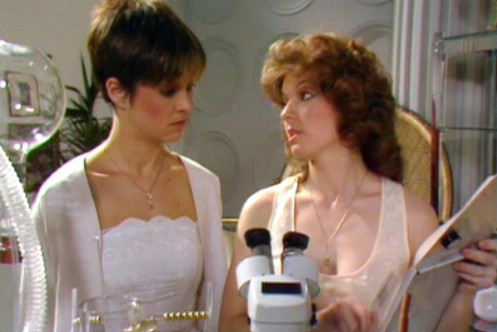 Tegan talks with Nyssa as she works in her lab in their room onboard the TARDIS. / Photo Credit – BBC Studios’ Doctor Who
Tegan talks with Nyssa as she works in her lab in their room onboard the TARDIS. / Photo Credit – BBC Studios’ Doctor Who
Turlough and the Black Guardian Saga: An Odd Interlude
During the Fifth Doctor’s travels, Adric frequently piloted the TARDIS, and even Tegan learned basic TARDIS operation. Nyssa and Tegan even flew the TARDIS to Castrovalva to save the Doctor during his regeneration. When Turlough (Mark Strickson) joined the TARDIS crew, being from Trion, he too was comfortable with TARDIS controls, further emphasizing the capable nature of the Fifth Doctor’s companions.
Turlough’s Unwelcome Arrival
Initially, Turlough was not a welcome addition in my eyes. My notes at the time reflect strong disapproval: “BUT FUCKING TURLOUGH ASKS TO JOIN THE CREW AND THE DOCTOR SAYS, ‘I THINK YOU ALREADY HAVE’ AND SHAKES HIS DOUCHE BAG HAND AND LETS HIM STAY WHAT IN THE ACTUAL FUCK I HATE HIM SO MUCH AND I HOPE THIS IS LIKE THE SIDE PIECE ROSE BROUGHT FOR JUST ONE EPISODE IN SEASON ONE OR I HOPE HE DIES NEXT SERIAL AS I HATE TURLOUGH HE’S THE WORST.” My strong reaction stemmed from Turlough’s initially unpleasant personality.
The Black Guardian’s Bizarre Plot
Turlough’s introduction was tied to the return of the Black Guardian (Valentine Dyall), seeking revenge on the Doctor for his Key of Time interference. The Black Guardian’s plan was…unconventional: recruit a “douchie, whiny, self-indulgent, self-centered, asshole of a prep school student from Earth” and task him with assassinating the Doctor in exchange for universal travel. This bizarre plotline felt out of sync with the more nuanced narratives Doctor Who typically presented. The choice of Turlough as an assassin felt particularly odd, given his lack of any discernible lethal skills.
Growth and Redemption: Turlough’s Arc
Despite my initial dislike, Turlough did grow on me. Mark Strickson’s portrayal was excellent, capturing Turlough’s initial unpleasantness perfectly. Using the sitcom family analogy, it felt like one of the daughters bringing home a “douchie college guy” who inexplicably became a main cast member. However, like Nyssa and Tegan, I eventually warmed to Turlough. His character arc, from reluctant assassin to loyal companion, was surprisingly well-developed.
The Brigadier’s Return: A Nostalgic Moment
Turlough’s introductory serial also marked the second-to-last appearance of Brigadier Lethbridge-Stewart (Nicholas Courtney). The Brigadier’s presence was a welcome nostalgic element, reminding me of the Third Doctor’s UNIT era, which I found incredibly refreshing. The UNIT family dynamic from the early ’70s era was something I deeply appreciated, and seeing the Brigadier again was a heartwarming moment. The desire for modern Doctor Who to revisit and develop UNIT in a similar way resonated strongly.
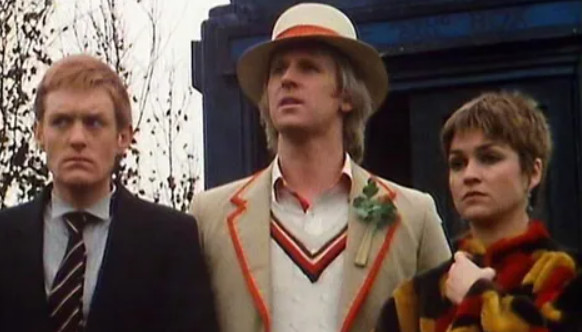 Turlough, the Doctor, and Tegan…and yes, he really isn’t *that* bad ;D. / Photo Credit – BBC Studios’ Doctor Who
Turlough, the Doctor, and Tegan…and yes, he really isn’t *that* bad ;D. / Photo Credit – BBC Studios’ Doctor Who
The Mara and Hindu Symbolism: Existential Horror
The Fifth Doctor’s era also featured the 20th Anniversary Special, “The Five Doctors,” marking the Brigadier’s final appearance. This special was a delightful celebration, bringing back Jon Pertwee as the Third Doctor and Patrick Troughton as the Second Doctor. Richard Hurndall capably stepped in as the First Doctor, and while Tom Baker declined to return as the Fourth Doctor, unused footage from “Shada” and a wax dummy were cleverly incorporated.
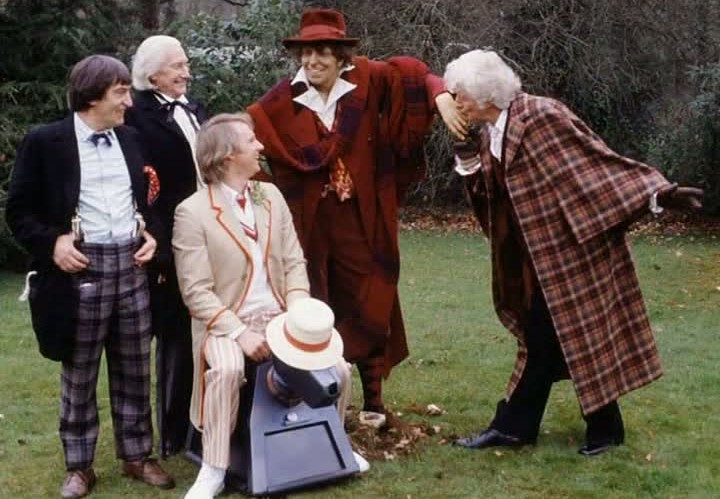 Jon Pertwee having fun with the fact that Tom Baker didn’t deign to return XD. I love, love, love Jon :). / Photo Credit – BBC Studios
Jon Pertwee having fun with the fact that Tom Baker didn’t deign to return XD. I love, love, love Jon :). / Photo Credit – BBC Studios
The Mara: A Deep Dive into the Psyche
Of the Fifth Doctor’s villains, the Mara was particularly notable, especially given its recent name-drop in the Fifteenth Doctor’s era. The name “Mara” carries significant meaning in Hinduism and Buddhism, adding a layer of depth to the narrative for those familiar with these traditions. The Mara episodes delved into psychological horror and existential themes, setting them apart from typical Doctor Who adventures.
Hindu Symbolism: Wisdom and Compassion
The Mara storyline unfolded on a lush jungle planet where the Doctor and his companions encountered human colonizers and the indigenous Kinda people, a matriarchal society led by Panna (wisdom) and Karuna (compassion). The Kinda society and their beliefs incorporated Hindu symbolism, including references to the Book of Jnana (wisdom). While presented through a 1980s lens, the intention to portray a nuanced indigenous culture with philosophical depth was evident. The emphasis on “Wisdom” and “Compassion” as leadership principles was a particularly compelling and meaningful element.
Tegan’s Nightmare: Existential Mindfucks
The Mara’s influence manifested as existential horror, primarily through Tegan’s nightmares. As Panna explained, “Wheel turns, civilizations arise, wheel turns, civilizations fall…. Wherever the wheel turns, there is suffering, delusion and death….It is the Mara who now turn the wheel. It is the Mara who dance to the music of our despair. Our suffering is the Mara’s delight, our madness the Mara’s meat and drink. And now he has returned.” These words encapsulate the Mara’s nature as a force feeding on despair and delusion, representing internal psychological struggles.
Defeating the Mara: Reflection as a Weapon
Ultimately, the Doctor and the Kinda defeated the Mara using mirrors. The Doctor explained, “No Mara can bear the sight of its own reflection. It must recoil from itself. Understandably, don’t you think, given its nature….[and then it] retreats back to where it came from,” or, “The dark places of the inside.” This resolution is a powerful metaphor for confronting inner demons – facing one’s own reflection, acknowledging inner darkness, and understanding that self-awareness can be a potent weapon against negativity.
 The Doctor and the Kinda defeat the Mara. / Photo Credit – BBC Studios’ Doctor Who
The Doctor and the Kinda defeat the Mara. / Photo Credit – BBC Studios’ Doctor Who
Descent into Darkness: Tragedy and Moral Ambiguity
The Fifth Doctor faced returning foes like the Cybermen, Omega, the Mara (again), the Black Guardian and the Eternals, the Master, and the Daleks. While the Fifth Doctor’s initial seasons had a lighter, sitcom-like tone, his era concluded with a descent into darkness and moral ambiguity, foreshadowing themes later explored in modern Doctor Who.
Adric’s Death: A Companion Lost
Adric’s death in the battle against the Cybermen marked a significant turning point. He became the first companion to die in classic Doctor Who. Adric’s sacrifice, staying aboard a ship plummeting towards Earth to avert disaster, was a heroic but tragic act. The ship crashed into Earth 65 million years ago, inadvertently causing the extinction of the dinosaurs. This dramatic event was shocking and impactful.
The Silent Credits: A Powerful Impact
The episode concluded with silent credits rolling over Adric’s shattered star badge. This unprecedented silence amplified the emotional weight of Adric’s death, a stark departure from typical Doctor Who endings. The silence spoke volumes, emphasizing the profound loss and grief.
Grief and Avoidance: Modern Echoes
Having known about Adric’s fate due to mentions in the 60th-anniversary specials, I was prepared. However, the impact in 1982 must have been immense, as companion deaths were not a common trope in classic Doctor Who. It likely felt as impactful as the Tenth Doctor losing Rose in modern series. The immediate episode depicted the TARDIS crew grieving, but in a very modern Doctor Who manner – burying the feelings and seeking distraction with a “fun” destination.
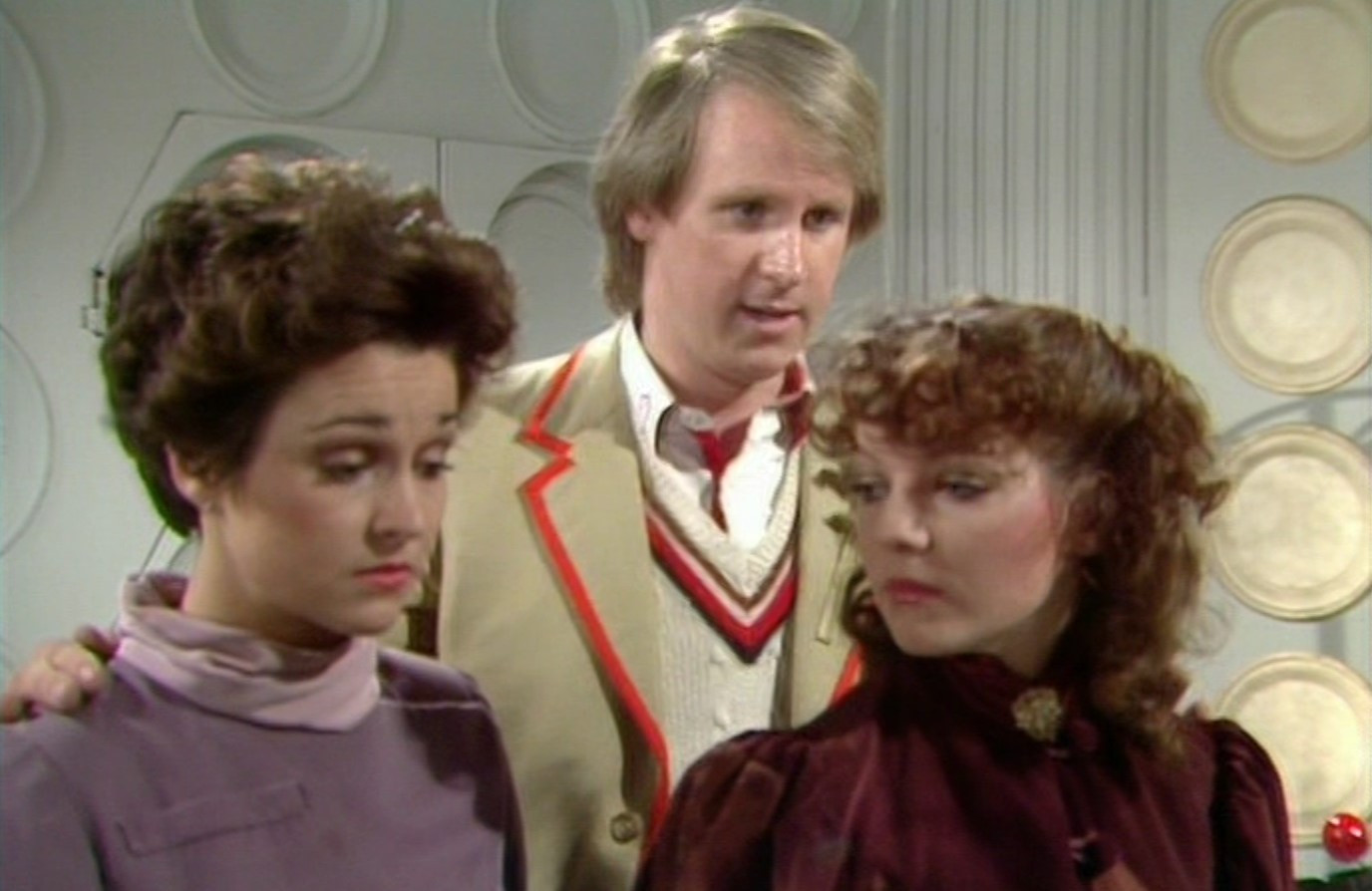 The Doctor does his best to console Tegan and Nyssa. / Photo Credit – BBC Studios’ Doctor Who
The Doctor does his best to console Tegan and Nyssa. / Photo Credit – BBC Studios’ Doctor Who
Tegan – “Aren’t you forgetting something rather important? Adric is dead.”
Nyssa – “Tegan, please.”
The Doctor – “We feel his loss as well.”
Tegan, “Well, you could do more than grieve. You could go back.”
Nyssa – “Could you?”
The Doctor – “No.”
Nyssa – “But surely the Tardis is quite capable of…”
Tegan – “We can change what happened if we materialize before Adric was killed.”
The Doctor – “And change your own history?”
Tegan – “Look, the freighter could still crash into Earth. That doesn’t have to be changed. Only Adric doesn’t have to be on board.”
The Doctor – “Now listen to me, both of you. There are some rules that cannot be broken even with the TADRIS. Don’t ever ask me to do anything like that again! You must accept that Adric is dead. His life wasn’t wasted. He died trying to save others, just like his brother, Varsh. You know, Adric had a choice. This is the way he wanted it.”
Tegan – “We used to fight a lot. I’ll miss him.”
Nyssa – “So will I.”
The Doctor – “And me. But he wouldn’t want us to mourn unnecessarily.”
Nyssa – “Where are we going?”
The Doctor – “Special treat to cheer us all up.”
 Nyssa and Tegan will travel with the Doctor for a long time…and I loved it! I loved their li’l TARDIS family so much :). / Photo Credit – BBC Studios’ Doctor Who
Nyssa and Tegan will travel with the Doctor for a long time…and I loved it! I loved their li’l TARDIS family so much :). / Photo Credit – BBC Studios’ Doctor Who
Murderous Intent: The Daleks and Davros
The darkness deepened when the Daleks returned. The Doctor resolved to murder Davros, stating, “Davros created the Daleks; he must not be allowed to save them… Once before I held back from destroying the Daleks. It is a mistake I do not intend to repeat. Davros must die.” This murderous intent was a stark contrast to the Doctor’s usual moral stance.
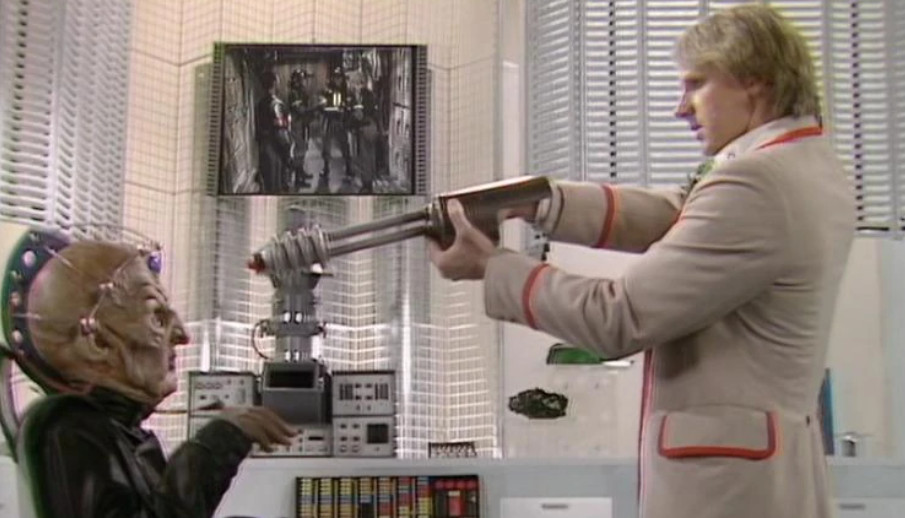 The Doctor prepares to murder Davros, as he’s been gunning down Daleks left and right. / Photo Credit – BBC Studios’ Doctor Who
The Doctor prepares to murder Davros, as he’s been gunning down Daleks left and right. / Photo Credit – BBC Studios’ Doctor Who
The Master’s Fiery End: A Dark Choice
Although he hesitated to kill Davros directly, the Doctor showed no remorse in gunning down Daleks and gleefully destroying them with bombs. The darkest moment, however, was the Master’s demise. The Master was restored by healing flames, which then turned to regular fire. As the Master burned alive, begging for mercy, the Doctor watched, refusing to intervene, even though he had the means to save him. The Master’s screams, “Help me! I’ll give you anything in creation! Please! Won’t you show mercy to your own…” ended in horrifying screams as he was consumed by the flames. This act of deliberate inaction, letting his oldest friend die, was profoundly dark and morally ambiguous.
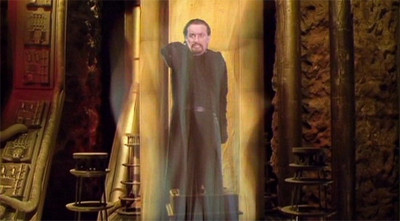 The Master demands, threatens, and then begs for his life as he burns alive with the Doctor looking on. / Photo Credit – BBC Studios’ Doctor Who
The Master demands, threatens, and then begs for his life as he burns alive with the Doctor looking on. / Photo Credit – BBC Studios’ Doctor Who
Peri Brown and a Changing Tone: The End of an Era?
This darker turn raised questions. Was it a reflection of the 1980s, with the rise of action heroes like in The A-Team, Magnum P.I., Mad Max, and Conan the Barbarian? Was there pressure to make Doctor Who more action-oriented? The influence of Star Wars was evident in the TARDIS scenes, with the Doctor frequently wrestling with the console, reminiscent of the Millennium Falcon.
Peri’s Arrival: An American Companion
After Nyssa and Tegan departed, Peri Brown (Nicola Bryant), an American companion from Baltimore, joined the Doctor. Was Peri’s introduction an attempt to inject a more American feel into Doctor Who? It’s a possibility, reflecting broader trends in media and entertainment at the time.
Peri and the Doctor / Photo Credit – BBC Studios’ Doctor Who
A Darker Tone: 80s Action Influence?
While the darker tone emerged towards the end, it didn’t overshadow my overall impression of the 5th Doctor. His warmth, empathy, and the family vibe of his TARDIS team remained central. The shift in tone might reflect the changing television landscape of the 1980s, but it also added a layer of complexity and foreshadowed the darker themes that would become more prominent in later Doctor Who iterations.
Conclusion: A Doctor Who Captured Hearts
Despite initial hesitation, Peter Davison’s Fifth Doctor completely won me over. I loved his warm, empathetic nature, the sitcom-like family dynamic, and his endearing quirks. His habit of tossing and catching a cricket ball, a thinking aid I also use, his coin tosses for decisions (often reversed), and his genuine confusion about cricket itself—all added to his charm.
Cricket, Coins, and Charm: Fifth Doctor Quirks
The Fifth Doctor’s quirky habits, like playing with his cricket ball, tossing coins for decisions, and his endearing confusion about cricket, added layers to his personality. These small, humanizing details made him relatable and further endeared him to viewers. His charm wasn’t just in grand gestures, but also in these subtle, everyday actions.
From Hesitation to Love: A Complete Conversion
For all my initial reluctance to move on from Tom Baker, Peter Davison’s 5th Doctor captured my heart quickly and completely. The Doctor, Nyssa, and Tegan – alongside both Adric and Turlough – became one of my all-time favorite TARDIS teams. My journey from hesitation to wholehearted appreciation of the Fifth Doctor is a testament to Davison’s captivating performance and the unique charm of his era.
A Favorite TARDIS Team: Lasting Impressions
The dynamic between the Fifth Doctor and his companions – Nyssa, Tegan, Adric, and Turlough – created a memorable and beloved TARDIS family. Their interactions, both humorous and poignant, contributed significantly to the enduring appeal of the Fifth Doctor’s era. This team dynamic, filled with warmth, humor, and occasional conflict, remains one of the most cherished aspects of classic Doctor Who.
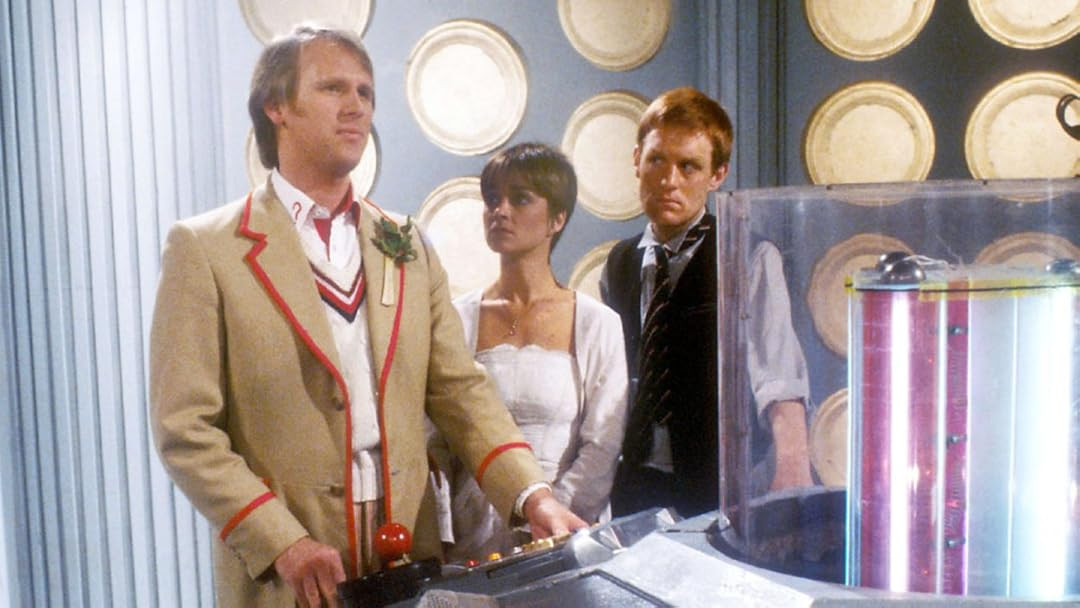 The Doctor, Tegan, and Turlough at the TARDIS console – whether with Adric, Turlough, or on their own, I could never tire of watching Nyssa and Tegan with the Doctor :). / Photo Credit – BBC Studios’ Doctor Who
The Doctor, Tegan, and Turlough at the TARDIS console – whether with Adric, Turlough, or on their own, I could never tire of watching Nyssa and Tegan with the Doctor :). / Photo Credit – BBC Studios’ Doctor Who
Further Adventures in Time and Space: Explore Other Doctors
Want to delve deeper into each Doctor’s regeneration? Explore my series:
- Impressions of the First Doctor
- Impressions of the Second Doctor
- Impressions of the Third Doctor
- Impressions of the Fourth Doctor
